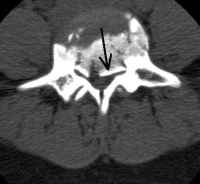The thoraco-lumbar region is an area that has the greatest incidence of fracture of any part of the spine. The fractures can be simple, such as transverse process fractures or much more complex such as fracture dislocations. Depending upon involvement of the nerves and the stability of the fractures, thoraco-lumbar spine fractures can be treated sometimes with a brace and sometimes with surgery.
The anatomy must be understood to know what can happen in this area. The spinal cord ends behind the first lumbar vertebra. The nerves that descend down the canal below this are called the cauda equina (horse’s tail in Latin and yes, combined together, they do look like a horse’s tail). Since compression of the spinal cord is more serious than compression of the nerve roots, fractures that cause canal compression are more serious in the upper part of the spine than in the lower spine.
If there is nerve or cord injury in a thoraco-lumbar spine fracture-generally surgery is recommended. Surgery gives the best chance to protect the remaining nerves and also gives the injured nerves the best chance to heal.
If there is no nerve or cord injury, then surgery may or may not be required. The most important facts to consider to avoid surgery are; is the spine stable in a brace, will it heal without a significant instability, is there the chance of pain if it heals in the position of fracture and will a deformity cause further wear over time?
Small fractures such as transverse process fractures are very painful but not dangerous. A period in a brace or even corset will allow these to heal or at least not continue to be painful.
Compression fractures are as they sound-compression of the body of the vertebra. Most of the time, these are not dangerous and will heal in a brace within three months. The vertebra will never regain the height they lost from the fracture, but most will heal with stablity and not cause significant future problems. The patient however may become a weatherman for a year as barometric pressure changes will cause some discomfort. It may be handy in the mountains to entertain your friends with predictions of the amount of snow fall that will occur.
Burst fractures are more unstable but still many can be treated in a brace. A burst fracture involves the entire body of the vertebra and small pieces of bone may be thrust into the spinal canal. If there is not significant compression in the canal, there is no nerve injury and the fracture appears stable (a discussion more advanced than will be included here), then it may very well be treated in a brace.
Are you suffering from symptoms of a Thoraco-Lumbar Spine Fracture?
Would you like to consult with Dr. Corenman about your condition?
You can set up a long distance consultation to discuss your
current X-rays and/or MRIs for a clinical case review.
(Please keep reading below for more information on this condition.)
Treating
One of the most significant factors in treating thoraco-lumbar spine fractures is the amount of angulation that occurs with the break. Remember that the area between the thoracic spine and lumbar spine is normally straight (see anatomy section). Most fractures cause a forward curve to occur called a kyphosis. Depending upon the degree of the forward curve or kyphosis, surgery may be warranted.
This is because without surgery the new curve will be permanent. The spine has to compensate for this new curve and most surgeons believe that 25 degrees of angulation is the maximum that the spine can compensate. Some believe that anything over 20 degrees is too much. To compensate without surgery, the lower spine has to bend backwards more to make up for the greater forward bend of the upper spine. This bend can cause greater wear of the joints in back (the facets) and can cause pain just by malalignment.
Fixing the spine surgically uses rods and screws to straighten out the deformed section and a fusion of the section performed to keep the spine straight. Any bone in the canal that causes problems should be removed.
If a brace is used to treat thoraco-lumbar spine fractures, the brace must be worn at all times. You would not remove a cast of your broken leg to take a shower for fear that the fracture would displace (separate). The same considerations should be given to a back fracture. Most fractures heal within three months. Then, when out of the brace, a physical therapy program is normally instituted to regain lost muscle strength.
When the fracture is healed, weaning out of the brace can be done in a twice a day removal pattern. Simply take the brace off for one hour in the morning and one hour in the evening. When that one hour is comfortable out of the brace, increase the time out of the brace by one half to one hour intervals until you are out of the brace full time. Occasionally, with muscle fatigue, you may need to temporarily put the brace back on.
For more information on research, study and analysis surrounding thoraco-lumbar spine fractures, please contact Dr. Donald Corenman, back pain specialist and spine specialist in the Vail, Aspen, Denver and Grand Junction, Colorado area.



